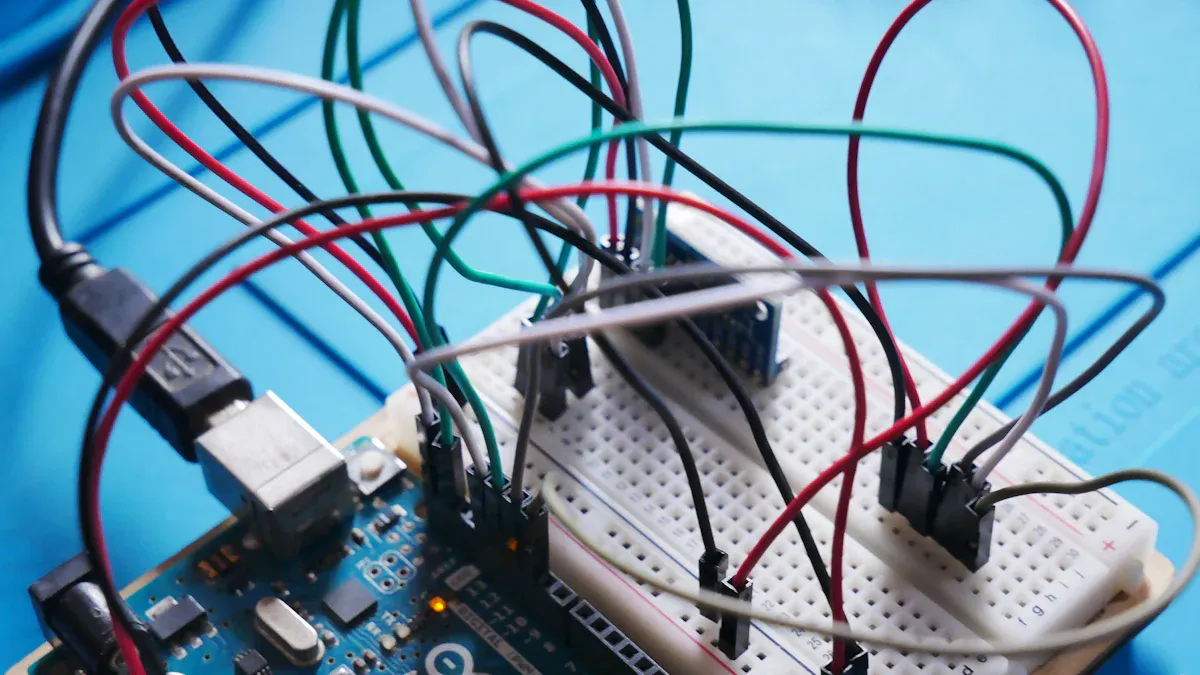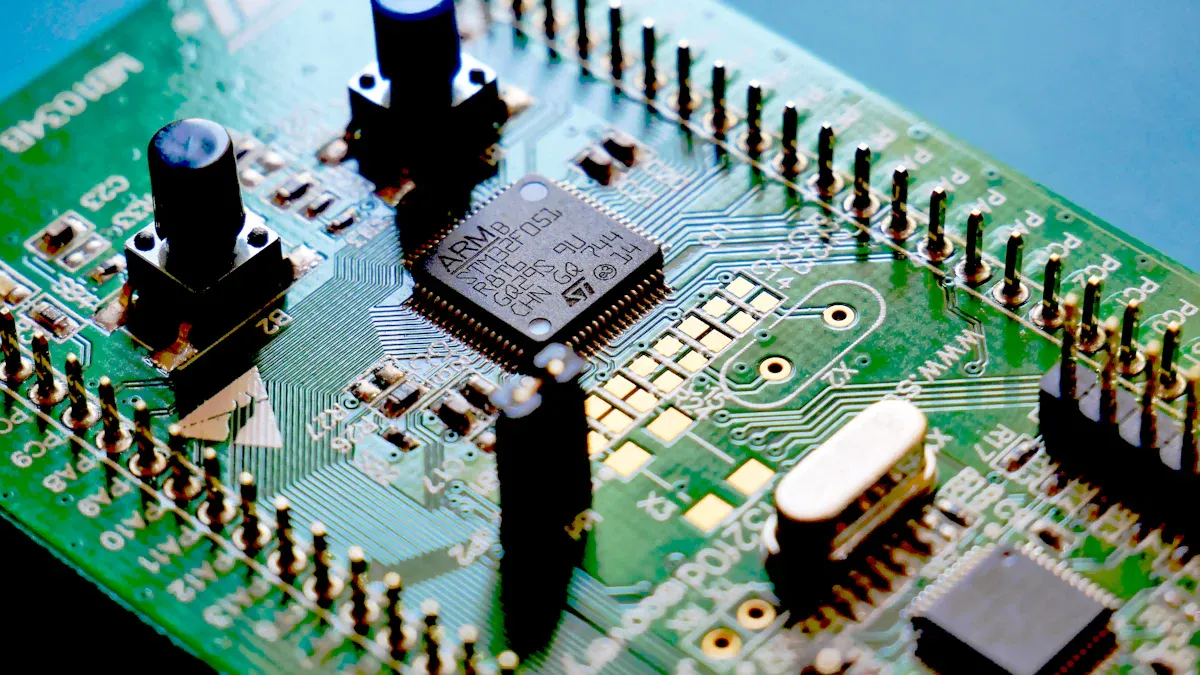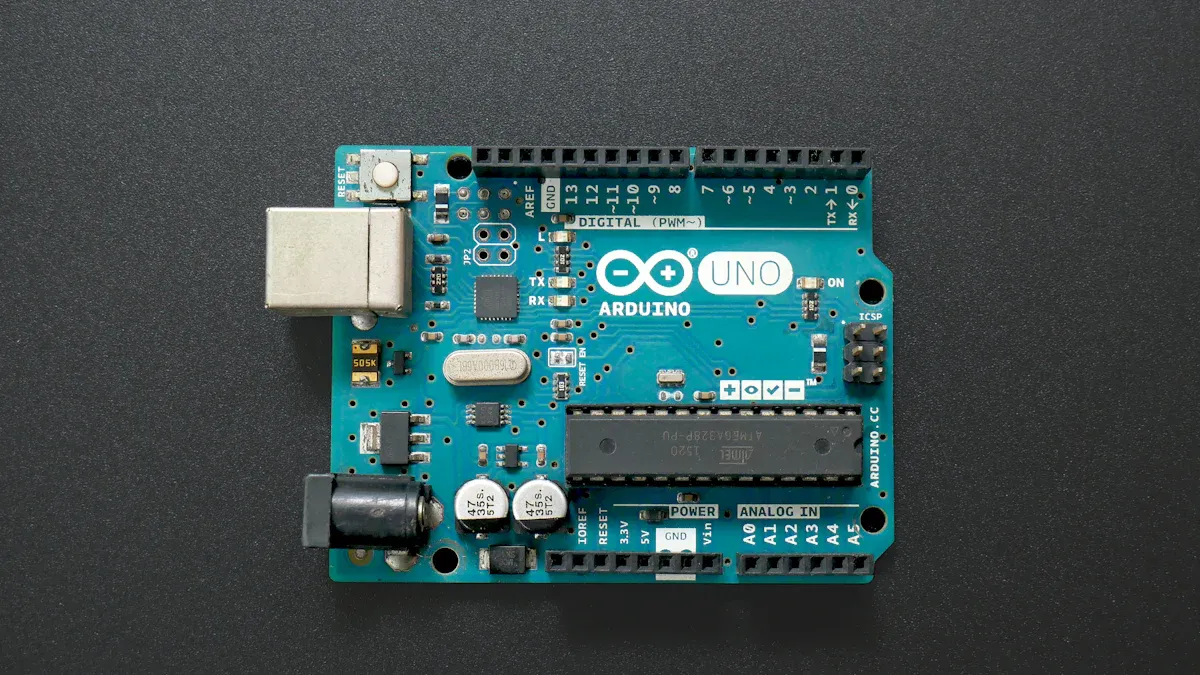What Is an MCU with FPU and Why Does It Matter for Embedded Systems

An MCU with FPU combines a microcontroller and a floating-point unit, enabling you to perform complex math quickly and accurately. Fast floating-point operations matter in embedded systems. Real-time applications, like control systems, rely on these operations to meet strict timing. Scientific studies show that MCUs with FPUs handle math tasks up to four times faster than those using only software. The chart below compares performance across different solutions.
Choosing an MCU FPU Microcontroller chip helps you achieve both speed and energy efficiency in modern embedded designs.
Key Takeaways
MCUs with FPUs perform math operations much faster and more accurately than software-only solutions, improving speed and energy efficiency in embedded systems.
Using an MCU with an FPU helps real-time applications like control systems and signal processing respond quickly and handle complex calculations reliably.
FPUs reduce coding complexity by handling floating-point math in hardware, making your code simpler and less error-prone.
Choosing an MCU with an FPU suits projects that need fast, precise math, such as automotive, industrial, and IoT applications, but consider power use and cost trade-offs.
MCUs with FPUs enable smarter, smaller, and more energy-efficient devices by combining control and advanced math in one chip.
MCU and FPU Basics

What Is an MCU?
You can think of a microcontroller (MCU) as a small computer on a single chip. It combines a processor, memory, and input/output (I/O) features all in one place. This makes MCUs perfect for controlling devices in everyday products.
Here are some key facts about MCUs:
MCUs have a CPU, memory (both RAM and flash), and I/O ports built in.
You find MCUs in alarm clocks, cars, medical devices, and smart home gadgets.
Popular MCU families include PIC, ARM, and AVR.
MCUs come in different sizes, from 8-bit to 32-bit, to fit many needs.
You usually program MCUs in C or assembly language, and the code stays in non-volatile memory.
A table below shows how two MCU models compare:
Parameter | STM32F407VET6 | |
|---|---|---|
Core | Arm Cortex-M0+ | Arm Cortex-M4 with FPU |
Memory | 32 KB Flash | Up to 1 MB Flash, 192+4 KB SRAM |
Clock Sources | 1–25 MHz | 4–26 MHz |
Communication Interfaces | 5 peripherals | Up to 15 peripherals |
What Is an FPU?
A floating-point unit (FPU) is a special part of a chip that handles math with decimals and very large or small numbers. You use FPUs when you need to do calculations like 3.14 × 2.71 or 1.23 ÷ 0.004.
Some important points about FPUs:
FPUs follow the IEEE 754 standard for floating-point math.
They handle special values like zero, infinity, and "not a number" (NaN).
FPUs can do addition, subtraction, multiplication, division, and even square roots.
Many FPUs support different levels of precision, such as single or double precision.
Tip: FPUs make math much faster and more accurate than doing the same work in software.
How They Work Together
When you use an MCU FPU Microcontroller chip, you get both the control power of an MCU and the math speed of an FPU. The MCU runs your main program and handles device control. The FPU steps in whenever your code needs to process floating-point numbers.
For example, if you build a robot that needs to calculate angles or speeds, the FPU does the hard math quickly. This teamwork lets your device respond faster and use less energy. You can create smarter, more efficient products by choosing a chip with both features.
MCU FPU Microcontroller Chip Differences
Hardware vs. Software Floating-Point
You can process floating-point math in two ways: hardware or software. An MCU FPU Microcontroller chip has a built-in floating-point unit. This hardware handles decimal math directly. If your chip does not have an FPU, the processor must use software routines to do the same work. Software floating-point uses many instructions for each calculation. Hardware floating-point uses fewer steps and works much faster.
Note: Hardware FPUs follow strict standards for math, so you get reliable results every time.
Performance and Efficiency
When you use an MCU FPU Microcontroller chip, you see a big jump in speed. Hardware FPUs finish math tasks much faster than software routines. This speed boost helps your device respond quickly in real-time control systems. You also save energy because the chip spends less time on each calculation. The table below shows how different MCUs perform in a common control loop:
MCU Model | Clock Speed (MHz) | FOC Loop Execution Time (us) | Notes |
|---|---|---|---|
ATSAME54P20A (Cortex-M4) | 120 | 12.4 | Fast execution due to hardware FPU and better memory access. |
STM32F446RE (Cortex-M4) | 120 | 15.5 | Slightly slower due to memory wait states. |
TI C2000 Delfino Series | Up to 300 | Not specified (very fast) | Real-time control loop runs efficiently with advanced FPU features. |
dsPIC (fixed point) | Equivalent | Slower | Software floating-point routines are much slower. |
You can trust these results because they come from real benchmarks. The EEMBC FPMark suite also shows that hardware FPUs handle many types of math, from simple addition to complex neural networks, with high accuracy and speed.
Precision and Application Impact
Precision matters when you work with floating-point numbers. Hardware FPUs use special designs, like the Brent-Kung adder and radix-4 Booth multiplier, to make math both fast and accurate. These designs help your applications run better, especially in areas like scientific computing, graphics, and machine learning. When you choose a chip with an FPU, you get reliable results even with very small or very large numbers. This precision lets you build smarter products that can handle advanced tasks.
Importance in Embedded Systems

Real-World Applications
You see MCUs with FPUs in many real-world products. These chips power smart devices that need fast and accurate math. For example, you find them in industrial machines that monitor motors and predict failures before they happen. Engineers use MCUs with FPUs in automotive systems to detect engine misfires or compressor faults. In smart buildings, these chips help control HVAC systems by analyzing sensor data in real time.
STM32 MCUs with FPUs, such as the STM32H7, run predictive maintenance in factories.
These systems collect data from sensors like accelerometers, current sensors, and thermocouples.
Tiny machine learning models, trained on this data, run directly on the MCU to spot problems early.
The chips process data at high speeds, sometimes sampling thousands of times per second.
You get alerts for issues through wireless connections like LoRa or Bluetooth.
This approach helps you catch problems early, reduce downtime, and save money. You can rely on MCUs with FPUs to handle complex tasks in small, energy-efficient packages.
Benefits for Control and Signal Processing
You often need to process signals or control machines in embedded systems. MCUs with FPUs make these jobs easier and faster. For example, in medical devices like ECG monitors, the FPU helps remove noise from heart signals and detect pulses with very little CPU power. You can run advanced math, such as filtering and feature extraction, right on the chip.
Using an MCU with an FPU lets you combine control and signal processing in one device. This reduces system complexity and lowers costs.
You also gain flexibility. You can use both integer and floating-point math, depending on your needs. Many MCUs, like the Cortex-M4 and Cortex-M7, come with free DSP libraries. These tools help you develop software faster and make your products more reliable. You do not need a separate DSP chip, which means you can design smaller and simpler systems.
Floating-point units follow the IEEE 754 standard. This gives you high precision and reliable results, which are important for control systems and digital signal analysis. You can trust your calculations, even when you work with very small or very large numbers.
Energy and Speed Advantages
You want your embedded system to run fast and use as little power as possible. MCUs with FPUs help you reach both goals. The FPU handles math operations in hardware, so your chip spends less time on each calculation. This means your device can respond quickly to changes, which is important in real-time systems.
In audio and digital signal processing, you need to process signals with high accuracy and speed. MCUs with FPUs, such as the ESP32-S3 or ARM Cortex M4, support single-cycle floating-point multiplication. This feature boosts performance in tasks like audio synthesis or sensor data analysis. You can use industry-standard development tools and libraries, making your job easier.
You also save energy. Because the FPU finishes tasks quickly, the chip can spend more time in low-power modes. This extends battery life in portable devices. You get a balance of power, speed, and cost that is hard to match with older fixed-point or software-only solutions.
When you choose an MCU FPU Microcontroller chip, you give your product the ability to handle advanced math, process signals, and control machines efficiently. This makes your embedded system smarter, faster, and more reliable.
Selection Considerations
When to Choose an FPU
You should consider an MCU with an FPU when your project needs to handle a lot of math. If you work with digital signal processing or need to process sensor data quickly, an FPU can make your job easier. Floating-point arithmetic also makes your code simpler and less error-prone compared to fixed-point math. Here are some signs that you need an FPU:
Your application uses complex math, like trigonometry or filtering.
You want to reduce coding complexity and avoid tricky fixed-point calculations.
Your project needs fast results, especially with a 32-bit MCU running at high frequency.
You need reliable results for both very large and very small numbers.
You should also think about power use. MCUs with FPUs can use more energy, so check if your project can support this.
Application Scenarios
MCUs with FPUs work well in many industries and solutions. The table below shows where you might use them:
Industry Sectors | Solution Domains |
|---|---|
Automotive | Audio, Motor Control, Safety |
Communications Equipment | Connectivity, Security |
Industrial | Edge AI, Power & Energy Management |
IoT Applications | Human-Machine Interface, Sensing |
Personal Electronics | Lighting, Sensing |
Some MCUs include extra math features, like CORDIC for fast trigonometric functions or FMAC for filter operations. These features help you build smarter and faster systems.
Trade-Offs
When you choose an MCU FPU Microcontroller chip, you balance speed, power, and cost. MCUs with FPUs often cost more than basic models. They may use more power, but they finish tasks faster, which can save energy in the long run. For example, a wireless low-power MCU with an FPU can give your IoT device longer battery life without raising costs too much. The right choice depends on your needs. If your project runs complex math often, the benefits of an FPU outweigh the extra cost and power use. If you only need simple control, a basic MCU may work better.
A comparison of two MCUs shows that the one with an FPU, running at a higher frequency, completes tasks in less time. This can lower total energy use, even if it uses more power while active. You should also consider how much memory and which peripherals you need. The best choice matches your application’s math needs, energy limits, and budget.
You gain real advantages when you choose MCUs with FPUs for embedded systems. These chips deliver faster math, lower energy use, and high accuracy. The table below shows how much you can improve your project:
Metric | Improvement Range | Description |
|---|---|---|
Energy-to-solution | Less energy needed for each task | |
Speedup | Up to 60% | Faster performance with almost no loss in accuracy |
Accuracy | Minimal error | Keeps results precise, even with big speed improvements |
Think about your application’s needs. The right chip helps you build smarter, more efficient products.
FAQ
What is the main benefit of using an MCU with an FPU?
You get much faster math calculations. The FPU handles decimal numbers quickly. This helps your device respond faster and use less energy.
Do all embedded projects need an FPU?
No. You only need an FPU if your project does a lot of math with decimals or needs high speed. Simple control tasks work fine without one.
Can you use the same code on MCUs with and without FPUs?
You can often use the same code, but you may need to change some settings. Code runs faster on MCUs with FPUs. Some math libraries work best with hardware FPUs.
Does an FPU increase power use?
An FPU may use more power while active.
It finishes tasks faster, so your device can sleep longer.
You often save energy overall.
See Also
Exploring MCU Microcontrollers: Functions And Core Principles
A Beginner’s Guide To Microcontrollers And Flash Memory
Top Features Of 32-Bit ARM Cortex MCUs To Know
